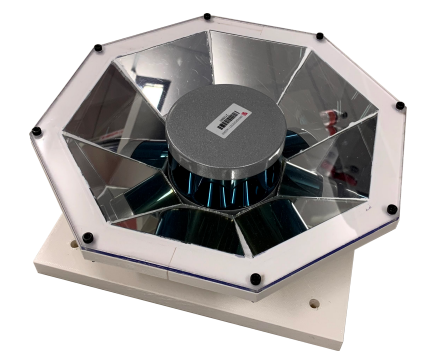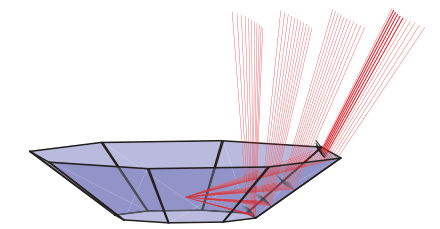
The patent titled “Reflector for reflecting electromagnetic waves from a rotating electromagnetic wave source” has recently been granted as a European patent by the European Patent Organization (EPO). The core of the patented invention is the ability to reshape the field of view from a spinning LiDAR while also maintaining the high resolution and refresh rate. The patented invention is a result of work performed in Work Package 3. The owner of the patent is University of Agder, and the inventors are SFI Offshore Mechatronics alumni Atle Aalerud and Joacim Dybedal.
Light Detection And Ranging (LiDAR) is a type of 3D scanner and uses lasers to measure the distance to and position of objects within a defined Field of View (FOV). The set of 3D point measurements from a 3D scanner can have hundreds of thousands measurements, and is referred to as a point-cloud. For decision support and automation, the point-cloud needs further processing using machine vision algorithms such as object detection and object classification.
The FOV of a spinning LiDAR is typically fixed at 360° horizontally and between 22.5° and 90° vertically. If your application requires omnidirectional 360° horizontal FOV then a spinning LiDAR is a good choice. However, if the applications require less than 360° horizontal FOV, using the spinning LiDAR directly will be inefficient. A portion of the lasers will be directed outside of the target scene and must be discarded. E.g., if only 120° horizontal FOV is desired, then applying a spinning LiDAR would discard 67% of the measurements. The information carried by the discarded measurements will be wasted and the cost of the useful measurements will be very high.
In camera applications the FOV can be easily adjusted optically by pairing an image sensor with an appropriate lens. The patented invention uses a similar approach, wherein a spinning LiDAR is paired with an appropriate reflector matching the desired FOV. By adjusting design parameters such as number of segments and individual tilt angles, the reflector can be configured to maximize point cloud density, maximize coverage, or a combination. In this manner the number of useful measurements can be close to the full resolution of the LiDAR. By narrowing the FOV, the density of the point-cloud increases which in turn can improve the performance of the machine vision algorithms. The invention thus enables increased performance at a lower cost.
The reflector invention is a typical example of technology which is wanted by the industry partners, but development of sensor systems is outside of their core business. They are primarily users of such systems, and rely on vendors to supply commercial products and services. For this reason University of Agder initiated a process to secure IPR rights and exploration into how to commercialize the concept. This process is still ongoing.
A detailed description of the concept and experimental results is available in the publication “Reshaping Field of View and Resolution with Segmented Reflectors: Bridging the Gap Between Rotating and Solid-State LiDARs“.

